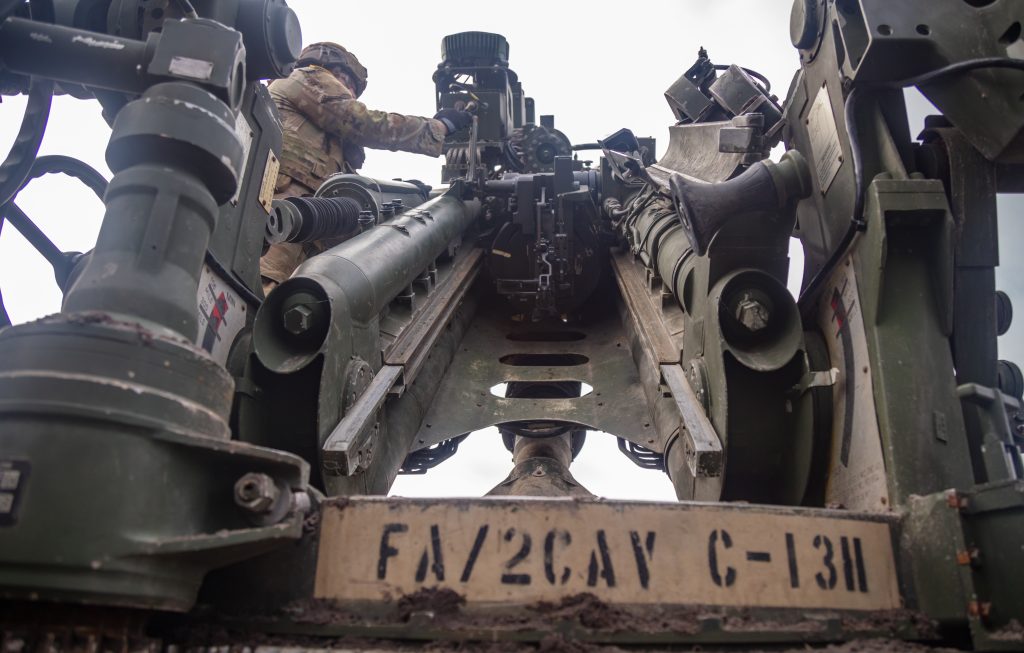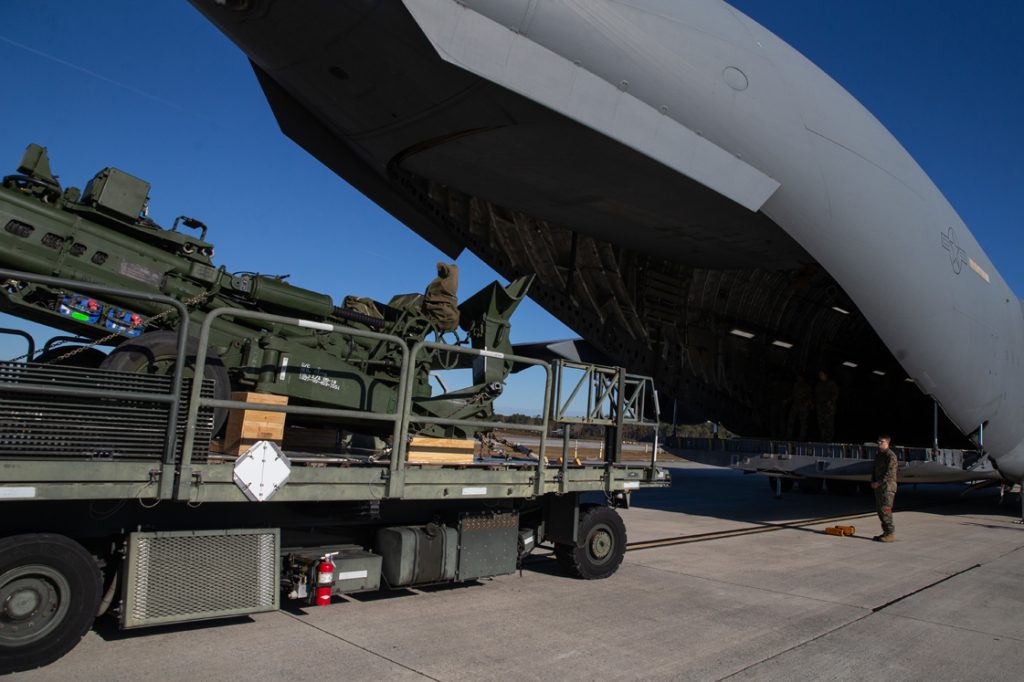
ON THEIR WAY: A CH-47 Chinook helicopter ferries an M777 155 mm howitzer in April 2023 on Joint Base Lewis McChord, Washington. Presidential Drawdown 7, approved on April 13, 2022, provided the first M777 howitzers for Ukraine. (Photo by Pfc. Elaina Nieves, 122nd Theater Public Affairs Support Element)
JPEO A&A program management offices provide Ukraine with M777 howitzers, 155 mm ammunition and ongoing support during an evolving mission.
by Chris Hatch, Chris Ayoub and Jeff Lee
The number of M777 howitzers that have been provided to Ukrainian Armed Forces (UAF) and the number of 155 mm rounds that have been fired during the past year of combat is well documented. What is less known is the ongoing support being provided to Ukraine to ensure continued M777 effectiveness, and the partnerships being developed.
As the number of different weapon systems being provided by the United States and international partners continues to grow, Ukrainian Armed Forces frequently cites the capability being provided by the Joint Program Executive Office Armaments and Ammunition (JPEO A&A), telling new stakeholders that in addition to the “kit”—the hardware they are providing (in this case M777 and ammunition)—they require enduring capability to ultimately defeat Russia. This article will discuss some of the capabilities being provided, and how JPEO A&A is now looking to parlay these capabilities into long-term partnerships.
KITS ENSURE MISSION CAPABILITIES
The first call came April 13, 2022, when Presidential Drawdown 7 was approved with the requirement for 18 M777 155 mm towed howitzers (12 Army and six U.S. Marine Corps) to be provided to support Ukraine. JPEO A&A’s Program Manager for Towed Artillery Systems (PM TAS) immediately sent field service representatives and subject matter experts to work with donor units to ensure their howitzers were fully mission capable or to document any discrepancies so issues could be resolved before transfer to Ukraine. As of July 7, 2023, 198 M777 have been committed to Ukrainian Armed Forces. The M777’s transportability capabilities were key to the rapid response, as six howitzers can be loaded into a C-17 to quickly deliver overmatch cannon artillery firepower wherever it is needed.

FIRE AWAY
U.S. Soldiers assigned to 2nd Cavalry Regiment fire an M777 howitzer during a live-fire exercise in April 2023 at the 7th Army Training Command’s Grafenwoehr Training Area, Germany. (U.S. Army photo by Markus Rauchenberger, Training Support Activity Europe)
RDC-U READY
The M777 was the first sustainable weapon or vehicle that was donated by the United States to Ukraine, and with that came several firsts. Chief among those was the standup of multiple capabilities at the staging and retrograde site in Poland now known as the Remote Maintenance and Distribution Center – Ukraine (RDC-U). A core team of experts was quickly established, helping to conduct limited technical inspections, maintain and repair equipment and establish and support various tele-maintenance functions with Ukraine. Initial engagements with Ukrainian Armed Forces were analogous to middle school dances, but over time evolved to a true partnership that is a credit to the enterprise team. For the M777 alone, three group chats with various levels of technical expertise run concurrently to support Ukrainian Armed Forces operations day and night. Weekly touch points are conducted via video with Ukrainian Armed Forces personnel at various depot facilities and field units to identify and rectify issues.
The other primary function of the RDC-U is to generate traditional demand-based spare part requisitions based on group chats and tele-maintenance activities with Ukrainian Armed Forces. Recognizing that the lead times associated with fulfilling demand-based requisitions were often not fast enough to maintain high operational availability, a JPEO A&A push package concept was developed to compliment demand-based requisitions. Starting with historical parts demand data, brainstorming sessions were conducted with M777 experts to predict component failure rates based on reported and projected battlefield operations. Combining these projections with input received from Ukrainian Armed Forces, push package lists were developed and bulk orders for projected high demand components were placed so spare parts could be strategically pre-positioned closer to the battle to decrease system downtime, increasing operational availability.
The resulting push packages are being sourced from the original equipment manufacturer, the U.S. government organic supply system, and U.S. organic industrial base partners. Consisting of parts valued at approximately $40 million, push packages have been crucial in maintaining materiel availability for the current high intensity battle. It is truly a joint effort from across the U.S. Army acquisition and sustainment enterprise that has enabled the sustainment mission for Ukraine.
As the war in Ukraine progressed, Congress approved various authorities giving the enterprise additional tools to ensure the capability required to maintain the ongoing operations tempo could be sustained. The sustainment contract used to provide M777 spares has received expedited approvals to increase the contract ceiling cost required to ensure the parts continue to flow. Defense Priorities and Allocations System authorities have been used to work with industry to prioritize its defense work to significantly shorten production lead time for critical spares. A temporary waiver to the Stratton Amendment, which restricts the export of technical data for large-caliber cannon technology, has also been granted. This waiver has allowed the enterprise to now seek second sources for critical high demand cannon components.

INTO THE BREECH
A U.S. Army cannon crew member assigned to 2nd Cavalry Regiment checks an M777 towed 155 mm howitzer in March 2023 during Exercise Dynamic Front 23 at Oksbol, Denmark. (Photo by Sgt. 1st Class Theresa Gualdarama, 117th Mobile Public Affairs Detachment)
As part of the transition from kit to capability, the JPEO A&A team planned and executed multiple echelons of M777 maintenance events during summer 2022. Initial training events consisted of operator and field level training, and then transitioned to a near depot level training course, as Ukrainian Armed Forces were very quick to grasp all training aspects. Each course’s duration varied, requiring the new equipment training team to spend several months at the Grafenwoehr Training Area in Germany, training approximately 80 students. The JPEO A&A team also conducted multiple precision guided munitions training events, instructing over 75 students on the employment of precision munitions, which have proven to be a difference maker on the battlefield. Each training event was conducted as an eight-hour program of instruction, condensed to align with Ukrainian Armed Forces operational needs. There were common themes throughout the training events: appreciation from UAF personnel, relationships built between student and instructor, and UAF introduction to the support available at the RDC-U to aid in sustaining weapon systems.
The severe operations tempo and concept of operations being used in Ukraine have resulted in challenges never seen in the almost 20 years the M777 has been in the field, including significant usage in Afghanistan and Syria. These challenges have resulted in some creative solutions to field issues. The team at the RDC-U is backed up by additional personnel stateside helping to quickly redesign components and implement new approaches to improve operational availability. The JPEO A&A team has leveraged existing partnerships with partner nations under the M777 Memorandum of Understanding and Project Arrangement to rapidly develop and prototype an alternate design for a safety critical component now undergoing qualification for urgent release. Critical repair procedures for various subassemblies have been created and shared with Ukraine, which has allowed for howitzers that have been battle damaged to be restored.
To provide a full set of capabilities, a comprehensive suite of technical documents has been provided to facilitate operation, maintenance, repair and sustainment of the M777. This technical suite consists of existing technical manuals, custom-developed quick guides focused on critical tasks, historical safety messages, white papers and tailored procedures to address Ukraine-unique issues.
Lessons learned sessions with other program offices has allowed this “secret sauce” to be replicated for other weapon systems, ammunition and vehicles that have been donated to Ukraine. On various occasions, Ukrainian Armed Forces have applauded the work the JPEO A&A team has done, stating that the M777 support construct should be replicated for all weapons and vehicles, as it has resulted in consistently higher operational availability compared with other donated systems.

PACK ’EM IN
U.S. Marines and Airmen guide an M777 towed howitzer into a U.S. Air Force C-17 at Marine Corps Air Station Cherry Point, North Carolina in 2021. The M777’s easy transportability was key to the rapid supply of Ukraine. As many as six M777s can be loaded into a C-17. (Photo by Cpl. Lauren Salmon, 2nd Marine Aircraft Wing)
PARTNERING BETWEEN PARTIES
JPEO A&A now conducts monthly engagements with Ukrainian Logistics Command, meeting outside of Ukraine, maintaining a high level of communication for ongoing operations, which has resulted in more of a partnering relationship between parties. Workshops conducted by the Security Assistance Group – Ukraine have brought together various government agencies, current industry partners and potential new industry partners from Eastern Europe. The goal of these workshops is to discuss a phased approach to provide depot-level repairs closer to the frontline and ultimately transition capability to Ukrainian industry. The capability developed would support donated howitzers, including the local manufacture of spare parts and a potential new system production build as Ukrainian Armed Forces transition to fewer types, but larger quantities of NATO systems.
CONCLUSION
What started out as a call to ship M777s into Ukraine has quickly evolved into using all the expertise and functions that program management offices were established to provide. In just over a year, tremendous capability has been provided to an armed force previously unfamiliar with U.S. and NATO systems to establish effective brigade combat teams, all while prosecuting a war. JPEO A&A is now looking at how to transition that capability into new partnerships, strengthening key alliances while growing the arsenal of democracy.
For more information, go to https://jpeoaa.army.mil/Project-Offices/PM-TAS or email usarmy.pica.peo-ammo.list.pm-tas-opscell@mail.mil.
CHRIS HATCH is the acting program manager for PM TAS at JPEO A&A. He holds an M.S. in management of technology from Stevens Institute of Technology and a B.S. in mechanical engineering from Manhattan College. He holds the DAWIA Advanced certification in program management.
CHRIS AYOUB is the Ukraine project lead and acting deputy program manager for PM TAS. He holds a B.S. in mechanical engineering from Rutgers University and the DAWIA Advanced certification in program management.
JEFF LEE is product support manager and supervisory logistics management specialist at PM TAS. He holds a Master of Engineering in systems engineering from Stevens Institute of Technology; an M.A. in leadership and management from Webster University; and a B.S. in industrial engineering from Rutgers University. He is a Defense Acquisition University Senior Service College Fellowship graduate.







